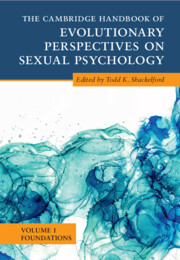Book contents
- The Cambridge Handbook of Evolutionary Perspectives on Sexual Psychology
- The Cambridge Handbook of Evolutionary Perspectives on Sexual Psychology
- Copyright page
- Contents
- Contributors
- Preface
- Part I Foundations of Evolution
- 1 Natural Selection
- 2 Sexual Selection
- 3 Inclusive Fitness Theory
- 4 Adaptive Problems in the Domain of Human Sexuality
- 5 Adaptations, By-products, and Spandrels
- 6 Evolved Psychological Mechanisms
- Part II Middle-Level Theories
- Index
- References
5 - Adaptations, By-products, and Spandrels
from Part I - Foundations of Evolution
Published online by Cambridge University Press: 30 June 2022
- The Cambridge Handbook of Evolutionary Perspectives on Sexual Psychology
- The Cambridge Handbook of Evolutionary Perspectives on Sexual Psychology
- Copyright page
- Contents
- Contributors
- Preface
- Part I Foundations of Evolution
- 1 Natural Selection
- 2 Sexual Selection
- 3 Inclusive Fitness Theory
- 4 Adaptive Problems in the Domain of Human Sexuality
- 5 Adaptations, By-products, and Spandrels
- 6 Evolved Psychological Mechanisms
- Part II Middle-Level Theories
- Index
- References
Summary
Organisms carry a large number of adaptive traits, i.e., traits that enable them to obtain resources and acquire sex partners from their social, biotic, and abiotic environments, and escape the negative factors of these environments. When we recognize an adaptive trait, we typically assume that it is a product of some form of selection, either of natural selection sensu stricto (environmental selection, as, for example, legs and eyes), sexual selection (e.g., antlers or peacock tail), or parental selection (e.g., the colorful interior of the beak of altricial birds’ nestlings). In many cases, the attribution of a biological function to the trait is simple and straightforward. However, even in such cases, we can be wrong – a particular trait could be an exaptation rather than an adaptation or it could be a by-product of processes other than selection. Sometimes we are not able to recognize what function a trait has for its bearer. The trait, including a behavioral pattern, can be a product of the manipulative activity of a biological entity other than the entity we suspect, usually another member of its species or a parasite. Besides, many traits are products of the organism’s own genes but help to spread their own copies at the expense of the biological fitness, viability, or fecundity of their carrier. A trait can also be a product of a different selection process. A trait might be a product of group selection or species selection, for example. Certain complex traits evolved only to keep an old biological adaptation in a functional state, not to evolve a new useful adaptation. And, finally, a trait can fulfill a function that was useful for the ancestors of the present organism but is not useful for the organisms that we study now. Similarly, a particular trait can be useful under special and rare conditions that are unknown to or otherwise not taken into consideration by the researcher.
Keywords
- Type
- Chapter
- Information
- Publisher: Cambridge University PressPrint publication year: 2022
References
- 8
- Cited by

